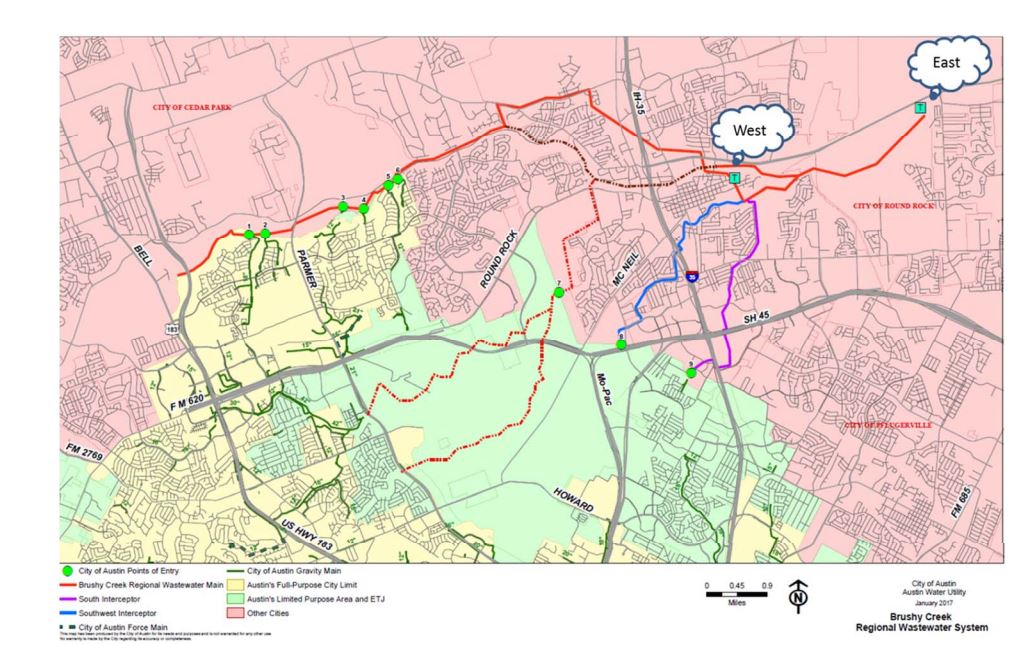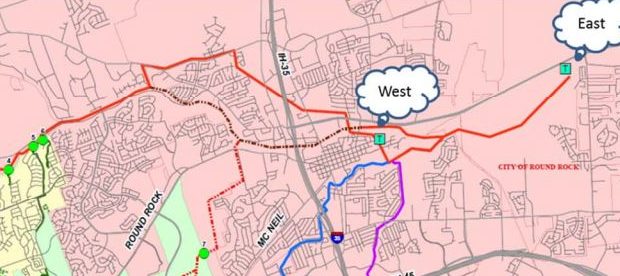Costly wastewater expansion gets OK
Wednesday, May 17, 2017 by
Sommer Brugal Only a few commissioners raised questions on various recommendations presented at the Water and Wastewater Commission’s regular meeting May 10. But when it came to the approval of interlocal agreements and costs related to the Brushy Creek Regional Wastewater System expansion, commissioners expressed significant concern with the project’s high price tag. The expenses they referenced are estimated to total more than $20 million.
The Brushy Creek Regional Wastewater System is located in southern Williamson County and treats wastewater within the Brushy Creek, Onion Creek, Chandler Creek and McNutt Creek watersheds. Austin, Round Rock, Cedar Park and Leander are partial owners of the plant and the system provides wastewater service to portions of each of the cities; Round Rock is the largest stakeholder. The expansion will increase Austin’s current plant capacity of 21.5 MGD, or average flows per month in terms of millions of gallons per day, to a total capacity of 38.5 MGD.
Chair William Moriarty wasted no time voicing his unease with the costs, saying he would probably vote against the recommendation based on the information at hand.
“I was very concerned about this (plan),” said Moriarty. “You’re going to have to take me through the math to get to $21 million.”
According to Bart Jennings, city of Austin utility strategic manager, the 13.5 MGD phase of the expansion, or phase two, is estimated to be $93 million. “Out of that 13.5, (Austin) only need(s) 3 MGD more than what (the city) already has,” he said. “Whatever that math is in terms of 13.5 divided by three, and that proportionate share times $93 million, should come out close to 20 million.”

Commissioner Melissa Blanding expressed similar concerns as Moriarty in terms of cost and asked for clarification regarding the contract’s proportions. Austin Water’s proportionate share of $20 million amounts to just 10 percent of the entire project.
“I was a little surprised by the size of this contract,” Blanding said. “I guess, since I’ve been here, I just don’t remember a project that was $20 million.”
Jennings agreed the cost is substantial, but said the expansion’s costs were believed to be reasonable. He said the cost per gallon for a wastewater treatment plant is relative to the types of cost indicated in the expansion plans.
There are approximately 3,800 residents contributing to Austin’s wastewater system discharging into the Brushy Creek System. Jennings said, with the expansion, the number of those connections is expected to increase to 24,800 residents by 2030.
Despite the high costs, Jennings said Austin’s participation in the expansion is in the city’s and the ratepayer’s financial best interest.
“If we choose to not participate and we go over our contracted capacities, we are in violation, in default, of the contract,” explained Jennings. He said going over capacity would result in one of two things. “We either turn to those that have the capacity available and we pay whatever price they want to charge for that additional capacity, or we do an expansion of the plants ourselves at our sole cost.”
Given the nature of those outcomes, and the growth ensuing in North Austin, Jennings said it’s prudent the city participates now.
Commissioner Mia Parton raised a question regarding Austin’s costs post-expansion, citing the additional $21,000 monthly costs for operations and management. Parton asked whether staff looked at any ongoing costs of the plant and whether or not negotiations of such costs were discussed.
Jennings said they expect costs to increase in accordance with the growing customer base. Still, though, Jennings said the city looks for opportunities to save and decrease costs whenever possible. He cited a contract for supplemental operations and management work with the city of Round Rock in 2014 to support his claim.
“By going to Round Rock, (they’ve said) the vast majority of this system is ours. On these kind of little things, we can all save some administrative expense if (Round Rock) just goes ahead and handles it (by paying the majority of the cost),” said Jennings.
The current expansion plan comprises two phases. Phase one is currently in discussion with an engineer, but no designs have been made. Jennings said possible modifications to some of the basins are being considered, but the first phase is expected to be in operating in 2019. Both expansions are expected to be completed by 2024.
After a lengthy discussion, the recommendation to City Council carried with Moriarty voting against, Commissioner Jesse Penn recusing himself and Commissioner Nhat Ho abstaining.

Table and map courtesy of the city of Austin.
The Austin Monitor’s work is made possible by donations from the community. Though our reporting covers donors from time to time, we are careful to keep business and editorial efforts separate while maintaining transparency. A complete list of donors is available here, and our code of ethics is explained here.
You're a community leader
And we’re honored you look to us for serious, in-depth news. You know a strong community needs local and dedicated watchdog reporting. We’re here for you and that won’t change. Now will you take the powerful next step and support our nonprofit news organization?













